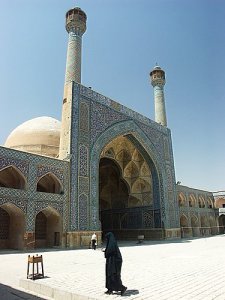Mosques are a sacred pillar in Islamic life and are living centers for civic and religious ceremony. They serve as schools for children and adults alike; they also host community, social and political functions. They can be thought of as a place of worship, wisdom, and fellowship. The Masjid-I Jami or congregation mosque in Isfahan Iran is one such mosque worthy of note. It was created in the 10th century and has steadily evolved from its start to fit and suit the needs of its population. This is not to say that the work completed on this edifice has merely been structural. There have been many great additions to the visual appeal of the mosque during its time to further deify and celebrate Allah and his role in the Muslim way of life. This mosque is a visual celebration of Islamic culture and this author will attempt to define some key areas that make this important fixture a work of living art.

Seljuk brickwork patterns on the Masjid-i Jami in Isfahan, Iran. Photo courtesy of http://www.islamicity.org
The FORM of the example is expansive. This mosque is a largely executed attempt to accommodate the male population of its community. It is a simple building which is then elaborately decorated by its caretakers or expanded to fulfill the needs of the community. The LINES are straight and precise for the general framework of the building. They are perpendicular and parallel in such deliberate quantities that a feeling of structure, safety, and ultimately righteousness can be found in its visage. This strict and functional canvas of structure compliments the COMPOSITION that the artisans have created in the way they have used a multitude of muslim muqarnas (a type of stacked niche) set along great vaulted arches. These features have within them even more niches that all of which tell a story or relay a quoted scripture from the Qur’an.
On this particular “canvas”, the MATERIALS and TECHNIQUE used to decorate and define this mosque are simply staggering. The façade is completed in a cobalt blue mosaic background with high levels of detail executed in contrast to the base color. There are borders of the mosaic tile around the arches and niches that serve to define the structure as well as design “themes” that differ based on where they are located (i.e. flat walls have a “basic” carryover design which then changes when the pattern reaches a minaret or dome, it then becomes more geometric in its appearance). The amount of visual data presented is truly overwhelming to the human eye. The painstaking amount of tedium that was needed to set these individually carved and cut pieces of tile and then place them in such a precise order so that they could resemble a required shape or even the Kufic Language is a masterstroke to the artists that created this monument.
The use of COLOR choice on this work is both striking and befitting of its purpose. The locale around this building (geographically speaking) is muted and generally restricted to earth tones. In defiance, this building stands in high relief to its environment being mainly composed of a deep blue mosaic covering. The Contrast in colors is a beacon to all who are within sight of it and serves as a constant reminder to its faithful following.
The area this community place occupies for its intended purpose is forever changing throughout its lifespan. The entire structure is devoted to ease the fundamentals of its religion and to allow for all way of procession to occur within it. Theses borders can then be expanded according to the needs of its following. This is an example of how SPACE was used when conceiving this artwork.
This has been a small summary of the basic components needed to objectively rate an artwork for what it and what it was meant to be. My rantings on this lovely mosque are by no means the only interpretations that can be concluded and are far from the results that an in-depth and scholarly study of the structure would derive. This writing was presented from a more generalist and amateur enthusiasts viewpoint.
